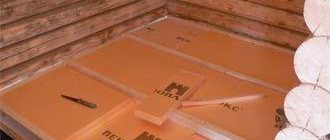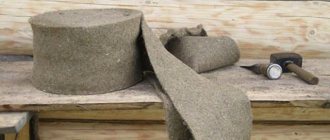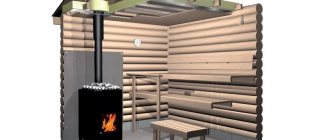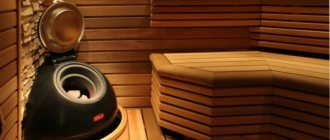Your own bathhouse is one of the most significant objects when planning any country house or country house. The heart of any sauna, of course, is the stove, and in the modern version - a boiler, gas, electric or solid fuel. To obtain hot water, most of our fellow citizens use the power of the same boiler systems, wood-burning “titans”, instantaneous or storage water heaters for the bathhouse. This publication will discuss methods of heating water in a bathhouse and the design features of water heating equipment.
How to choose the right boiler for a bath: requirements for a water heater
Your own bathhouse is one of the most significant objects when planning any country house or country house. The heart of any sauna, of course, is the stove, and in the modern version - a boiler, gas, electric or solid fuel. To obtain hot water, most of our fellow citizens use the power of the same boiler systems, wood-burning “titans”, instantaneous or storage water heaters for the bathhouse. This publication will discuss methods of heating water in a bathhouse and the design features of water heating equipment.
Sauna boiler made of metal pipe
The boiler made from a pipe can be positioned vertically, then the algorithm of work will be very similar to the previous version (see heater made from a barrel). Or maybe horizontally. In this case, the main actions are:
- Weld the legs.
- Grate bars. Inside the barrel, measure a third of the height from below. In this place, you can weld the fittings, or you can cut a sheet of metal to size (holes are drilled in it in advance).
- The pipe is welded.
- The boiler must be shut off at one end.
- Two doors are made in the end plane: a vent and a firebox.
- A heater (made of sheet metal or mesh) is made on the top of the boiler (where the pipe is).
- The water tank is made rectangular and “hung” on the back wall.
At the end of the work, you can give the boiler a “marketable appearance”: thoroughly clean all surfaces and paint with heat-resistant paint.
Types of water heaters for baths
Today, the Russian market of climate control equipment offers a wide range of boilers, which can be divided into two groups:
Water can be heated by open fire (in geysers) or combustion products (in wood heaters).
But there are several problems here:
If you do not have the opportunity (or desire) to deal with all the difficulties of obtaining permission to use a “gas pipe,” then there is only one option left - an electric boiler.
Flaws
Despite the numerous positive aspects, geysers also have disadvantages. Experts note the following disadvantages:
Another drawback, but not so significant, is the relatively low level of efficiency. In the case of a gas water heater, it approaches a value of 92 percent. If we are talking about the closest competitor, a boiler, then the efficiency of this device is almost one hundred percent.
Storage boilers
A storage type heater consists of a thermally insulated tank, a heating element, an automation unit and a safety group. In modern boilers, some manufacturers install a magnesium electrode, which prevents the formation of scale on the heating element and corrosion of the inner surface of the metal container. Installations of this type are available in both horizontal and vertical versions.
The principle of operation of the boiler is as follows: the tank of the device is filled with water, which is heated by a heating element to a temperature set by the owner in the range from 35 to 85 ° C. Once the temperature is reached, heating stops. When the liquid temperature drops by 0.5°C, the heating element automatically turns on and heats the water in the tank to the set temperature.
Advantages of using storage boilers in a bathhouse:
In addition, storage electric boilers are reliable, durable, fire and electrical safe.
The disadvantage is the large weight and dimensions.
Consumables
There are two popular methods for making boilers:
- From a finished 200 liter barrel.
- From a piece of large diameter pipe.
The dimensions of the unit may vary depending on the dimensions of the room and the wishes of the owner. But on average a workpiece is suitable:
- diameter from 60 cm;
- height 70 cm - 1 m;
- wall thickness (whether pipes or barrels) is 3 mm or more.
You also need to prepare in advance:
- chimney (diameter about 10 cm);
- a metal pancake with the diameter of the barrel, thicker than the barrel (from 5mm);
- water tap and tube 0.5 inches;
- hinges for 2 doors;
- material for door latches;
- fittings or corners (20 - 25 mm) for the grate;
- channel for the stand and partition between the heater and firebox;
- refractory or ceramic bricks to lay a screen around the stove;
- cement or clay mortar.
Questions and answers
Question: Many people ask where to hang the boiler in the bathhouse?
Answer: If a flow-type device is used, then it is mounted directly in the washing compartment. If a storage water heater is used, the best place would be the dressing room.
Question: What is better: a gas water heater or a boiler powered by electricity.
Answer: If the building is gasified, the best option would be a gas water heater. If there is no gas, definitely an electric boiler.
And as a conclusion: the reliability and durability of a bath boiler depends entirely on the wise choice and correct installation of the device, which is best left to professionals.
Source
Which heating element to choose
To supply hot water to the bath shower regardless of whether the stove is lit or not, water heaters powered from the mains are often used. They can be divided into two large groups:
Storage batteries behave calmly in cases where the voltage in the electrical network fluctuates, even within significant limits. But its installation is complicated by the fact that a tank with a very large volume is used as a storage tank. If it is possible to mount the latter away from the bath shower, for example, in the attic, then you should choose this type of water heater. Flow-through - have relatively small dimensions, are easy to install and have the lowest price. The use of instantaneous water heaters is complicated by the fact that a stable voltage in the electrical network and pressure in the water supply system are required. Before purchasing this type of water heater, it is best to test the electrical network in your home, determine the average voltage, peak and minimum. If the water pressure is insufficient, you can additionally install a pump to supply the bath to the shower.
Article on the topic: What to make caps for fence posts from
The cheapest and at the same time correct heating of water in a bathhouse
I haven’t tried any methods of heating water in a bathhouse. And not because all the options did not suit me, but because I try to understand all the advantages and disadvantages from my personal experience, so that later I can speak with confidence about the operation of this or that source of hot water.
But now it's time to make the perfect water heating system in your bathhouse, and here I will have 2 stages!
To begin with, I decided to replace my main hot water tank in the sink and installed a 75-liter horizontal tank from Ferrum, which had been in more than one test. I like this option the most in terms of volume, because... covers all my needs, both in form/connection.
I installed a 1.25 kW heating element into this tank and connected it to the network, using a regular light switch as a switch. A heating element in a tank is probably the ideal for heating water for me, because... does not depend in any way on the stove and combustion in it, and can heat the water when I need it. In addition, taking into account the constant change of stove equipment during the experiments, I don’t have to worry that I will be left without hot water for the next bath.
The tank itself hangs in the washing compartment, without affecting the microclimate in the steam room.
In fact, a heating element in a tank can be called the cheapest and, at the same time, the correct option for heating water! The cost of such a kit will consist of a tank (4500 rubles), a heating element (300 rubles), a switch (100 rubles), and you also need to add something for wiring, even 400 rubles, I didn’t need anything extra . The total is 5300 rubles.
For comparison. If you heat water from a stove and do it correctly, then you need some kind of register (let it cost 5,000 rubles), the same tank (4,500 rubles) and pipes with fittings to connect the tank and the register, and this is not cheap (even if it’s a set of stainless steel with fittings and a tap will cost 3 thousand rubles). The total is already 12,500 rubles!
Yes, electricity is not free. But even if you use heat for 4 hours each bath, then 1.25 * 4 = 5 kW * 4 rubles = 20 rubles per bath, or about 1000 rubles. in a year. Not so much, considering that additional firewood is also needed if you heat water from the stove!
Watch the video of how I installed and connected the heating element into the hot water tank!
I am in no way convincing that this is the only possible option for heating water in a bathhouse. Not at all! I am just sharing my opinion and the solution I came to after numerous experiments. And this will not be the only source of heating water in my bathhouse!
The next step is to connect the tank and oven to this! But I will do this in an unusual way and am going to make the best option for heating water from the stove and heating the steam room! But more about that next time!
Source
Sauna heater made from a metal barrel
The work progress step by step will be as follows:
- The legs (channel) are welded to the metal pancake.
- Use a chisel or ax to remove the bottom of the barrel. The resulting stand is welded in its place.
- They step back about 5 cm from the bottom of the barrel and cut out a hole for the future blower, measuring 10 x 15 cm.
- A door for the ash pan is made from the sawn fragment. The latch and hinges are attached to it. The finished door is welded to the desired location.
- A grate is made from fittings or corners. It is welded inside the container above the ash pan (5 cm).
- We step back another 10 cm. This is the base of the firebox door. Size – arbitrary (minimum dimensions – 25 x 40 cm). If the door is also made from a cut piece of metal. The hinges and valve are welded and installed on the boiler body.
- Now the heater. You can calculate its location like this: the entire height of the barrel minus the height of the ash pan. Divide the total by three. This is the size of the firebox height. And above it is a heater of the same size. A channel partition is welded in the right place. It is clear that the partition is not solid. The distance between the rows of the channel should be such that the prepared large stones do not fall through. And don't forget to leave room for the pipe.
- The heater can be made closed. In this case, the water tank will be located above the heater, and another hole needs to be made on the side through which stones will be laid and steam will be released. Or you can divide the remaining space in the barrel in half - make a water tank from one half, and an open stone from the second.
- The pipe is installed and welded. If it passes through the tank, the water will heat up faster from the heat of the pipe. And if you put a pipe through a heater, there will be more heat.
- A small (half-inch) tube is welded into the bottom of the tank. A tap is attached to the thread.
A little trick. When making a grate from corners, if you turn them “cup” up (so that ash accumulates inside), the grate will not burn out longer!
Selection, installation and alternative
To begin with, it should be mentioned that there are many ways to solve the issue of supplying hot water to a building. In this case, the simplest methods are to install a separate heater or use a stove for these purposes (see also the article Design of a stove for a bath: features).
Considering the large assortment of such products, the choice must be approached very responsibly, based on the technical conditions of the bath
Selection and installation
Installation and connection diagram of the boiler with wiring system
A separate machine should be installed for the heater
Advice! Each similar product has its own installation and operating instructions, recommendations and requirements, which should not be violated. Otherwise, you may damage the device or significantly reduce its service life.
Using a stove to heat water in a separate tank
Stove heating
However, if the steam room is made on the principle of a sauna, then the instructions for its operation do not imply the presence of wet steam in the room. Therefore, such stoves cannot be used, which means it is necessary to look for an alternative to heating (see also the article Steam room in a Russian bath: how to do it yourself).
Combined system using furnace and boiler
To solve this problem, professionals advise using fireboxes with a remote tank. In these systems, a small container or spiral of pipes is installed in the oven. It is connected to a tank in another room at different levels.
As a result, water from the furnace will flow under pressure and temperature into a common container, and from there the cooled liquid should flow back into the firebox. Such a water heater in a bathhouse is very similar to the principle of operation of a gas water heater, but only without the intense impact of fire. Therefore, it can be considered safe and quite effective.
Advice! Such water systems are the most economical and are made in the best traditions of bath culture.
Another combined system using two tanks
Flow heaters
These devices also operate on electrical energy, but at the same time heat running water. They do not require a long time to reach operating mode and function effectively from the moment they are turned on.
However, the price of such products is quite high, since cheap models are quite impractical and quickly break down. It is also worth noting that they have a fairly high energy consumption, which is not very economical.
The fact that these types of devices usually serve one consumer point also deserves special attention. They are not able to control the entire system.
Advice! When installing such a device, special attention must be paid to the power cable. The fact is that this equipment is quite powerful and requires conductors of the appropriate cross-section.
A dedicated flow-through heater that is often manufactured with single point service in mind
The easiest way
Manufacturers make sauna stoves with ready-made water tanks. This option is the simplest for installation and further operation. Relevant for buildings that do not have gas and water supply communications; a limit on the use of electricity has been determined.
Hot water tanks can be installed in two ways:
Placing such a tank inside the steam room is considered a disadvantage due to the large release of water vapor. For bathhouses located in the country, this is one of the few available ways to heat water that does not require any effort in winter arrangement. A current option for a classic Russian bath. It is not recommended to equip a sauna with such a tank.
Conclusion
In the video presented in this article you will find additional information on this topic. Also, based on the text presented above, we can conclude that a water heater that uses electricity for its operation can significantly increase the level of comfort in the bathhouse. At the same time, it will create a separate reserve if combined with standard systems using a furnace.
However, such a technological solution is not mandatory. A standard bathhouse can do without such devices, using traditional methods of heating water in the bathhouse.
Source
Features of iron heaters
By making a boiler with your own hands, a person gains freedom in what shape, what size the unit will be, where to place it and on which side to make the firebox. Will it stand on the floor or hang on the wall?
Wood-burning metal boiler for a bath
The most popular option is a wood-burning metal boiler. And it will always be so, because the crackling of the logs gives a special charm to the bathing process. In addition, this is the safest way to warm up the room well.
How to make a heat exchanger yourself?
It is not advisable to buy expensive stainless steel products for use in a bathhouse. You can easily make a heat exchanger for a sauna stove yourself. How to make a heat exchanger for a sauna stove with your own hands? Step-by-step instructions will be below.
Materials and tools
What materials are of primary importance for the heat exchanger of a sauna stove? Depends on how much water needs to be heated. Here is a sample list of what you will need:
- metal sheet, thickness 2-3 mm - S=2*(0.40*0.80+0.40*0.20)+0.80*0.20 = 2*(0.32+0.08) +0.16 = 0.96 m2
- tap Ø32 mm – 2 pcs.
- check valve Ø32 mm - 1 pc.
- fittings Ø32 mm—6 sets.
- pipes Ø32 mm - 6 pcs.
- valve Ø32 mm (for drainage) - 1 pc.
- metal pipe, corrugated Ø32 mm - 3 m.
- pipe Ø32 mm (cold water supply) - as needed.
- sealing cord for sealing connections - 1 pack.
- electrodes - 1 pack.
What tool is used? Here is the list:
- welding inverter;
- "Bulgarian"
- other tools.
Size calculation
The power of the heater must correspond to the power of the furnace itself. It is recommended to make a heat exchanger based on the following:
- The heat exchanger should not consume more than 10% of the power of the furnace itself. In this case, the power of the stove will be enough to heat the room. Fuel will be used as efficiently as possible. The heating time will not increase.
- The total length of the pipes should not exceed 3 meters. It is necessary to make the necessary slope, which is 2500 on the direct feed, and on the return one - more than 300 towards the stove. This way the coolant will be effectively supplied by gravity. Otherwise, you cannot do without a pump.
- There should be enough water. It should heat up for no more than two hours, but not boil. If you make the tank too small, the coolant will boil very quickly. If the boiler is located directly in the steam room, it will be very difficult to wash there. Heavy steam will fill the room and it will become impossible to breathe normally. If the volume of the metal tank is too large, the coolant may not heat up at all.
- Don't forget that when the stove burns out, the water should still remain hot for some time. Therefore, you need to provide the necessary power reserve.
Considering all of the above, let's try to choose the optimal metal heat exchanger. We assume that to warm up the air in the bathhouse you need 5 kW. Then the power of the metal heat exchanger will be 10 kW, and its area will be 1 m2. We will assign 3 kW to possible heat loss. Then installing 1 m2 of heat exchanger will give us 7 kW of energy. Water heating time is 2 hours. Then we determine the required heat exchanger area using the formula: S = 1/7*W, where
W = 0.00117*V*(tk-tн) /T= 0.00117*65*(70-10) /2= 2.3 kW, hence S = 1/7*W=1/7*2.3 = 0.33 m2, where S is the required heat exchanger area, m2;
W is the required power of the heat exchanger, kW (it is important to determine it correctly); V is the volume of water that needs to be heated, we take 65 liters (enough for 4 people); tk is the required water temperature, we take 700C (optimal hot water temperature); tn is the initial water temperature, we take 100C. The required furnace power is 5+2.3 = 7 kW. 0.3 kW can be ignored, because
10% of the initial furnace power is an acceptable loss (0.3 kW
0.3 kW can be ignored, since 10% of the initial furnace power is an acceptable loss (0.3 kW
Manufacturing instructions
- Let's make 2 water tanks correctly: one is best made in the shape of a cylinder (for the heat exchanger), the second is rectangular (remote). We calculate the sizes individually; it is better to proceed from the calculation above and your own needs.
Design options
- We make a coil and install it in the tank.
Coil design example 1
Example 2
Example 3
Example 4
- Fill with water and test for 6 hours. All seams must be sealed, there should be no stains or leaks. Keeping water in the tank at sub-zero temperatures is prohibited.
- We weld 2 pipes for forward and reverse (bottom) supply to organize circulation.
Need for additional heating
The classic option for heating a steam room for bathing procedures is a brick or metal heater.
In this case, additional equipment is used to maintain a given air heating temperature both in the steam room and in other rooms. It is impossible to ensure fast and uniform heating of the dressing room and rest room from a sauna stove.
And if in summer this does not cause problems, then in winter such a situation can lead to a decrease in comfort when organizing a bathing holiday. In this case, all the heat produced will be accumulated in the steam room, and the dressing room and other rooms of the bath will remain unheated.
Installation of additional heating equipment will ensure the maintenance of a comfortable temperature necessary for a long stay in the dressing room.
Installation of a water floor from a sauna stove
Initially, water heated floors were not intended for installation in a bathhouse. Therefore, when laying such a “pie” in a bathhouse, it is required to equip it with additional elements.
The installation of a water heated floor from a sauna stove includes several components:
The heated floor contour is the main working element, which is laid evenly across the entire floor of the room with a certain pitch, filled with a concrete-cement mixture screed. You should choose the right pipe model; in this situation, not every one will be suitable. It is best to use copper, metal-plastic or stainless steel corrugations. However, many people prefer cross-linked polyethylene pipes with increased heat resistance, with a service life of at least 30 years, or polypropylene pipes, with a warranty period of at least 50 years.
The mixing unit is an important part of the system, since the stove is not capable of heating the coolant to the required level. It heats the water almost to the boiling stage; in this state it cannot be supplied to the circuit. Therefore, a mixing unit is needed, in which boiling water will be mixed with the waste coolant to the required 40 degrees, and in this form it will be sent into the pipeline. It is used to regulate, configure and automatically maintain the temperature level of the heated floor in the desired mode.
Heat exchanger - a container, coil or register located above the firebox, where the liquid from the furnace is heated. When using antifreeze as a coolant, you will need to equip a separate heat exchanger, then the antifreeze will not be able to get into the washing water.
A circulation pump is necessary to ensure that the coolant is evenly distributed and moves through the pipeline. Without it, a warm water floor cannot function, as it provides the circuit with additional pressure for fluid circulation. When selecting the pump power yourself, you need to take into account the area of the heated room; the larger it is, the higher its performance should be.
To reduce the load on the pump, it is recommended to divide the pipeline into several parts of equal length.
Drainage is necessary to remove excess liquid from the steam room and washing room of the bathhouse. You can equip it with your own hands, taking into account the following two points: by constructing a water outlet - a drainage hole, through which the water will flow into the pipe and be discharged into the sewer pit; fill the screed with a slope in the direction of the drain hole - then all the water will flow towards the slope.











